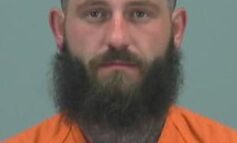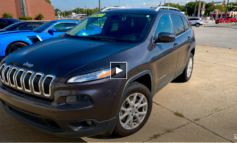At a vigil on Fairfield Avenue in Bridgeport in May, mourners gathered in the hundreds to remember a slain 15-year-old boy. Relatives and friends screamed in grief at the police who were watching from a Walgreens parking lot.
The appearance of Bridgeport Mayor Joe Ganim and Police Chief Armando Perez was not greeted warmly. The chief was heckled as he tried to place a candle at the site where one of his officers shot and killed Jayson Negron the day before. While at the vigil, Perez told reporters that he felt his officer had followed protocol and had done nothing wrong.
Negron was the driver of the vehicle, which police say was stolen and used by Negron to try to pin an officer. Julian Fyffe, the 21-year-old passenger in the car, was also shot and has said he and Negron were merely trying to stop, when Negron accidentally put the car into reverse, and police opened fire.
While the shooting is under investigation by state police, the case has raised questions about policing in Connecticut, particularly about police pursuit policy. By one count as of this writing, Negron is the sixth person to die in police pursuits in the state in 2017.
The other five deaths this year are: Tommy Clayton Brown and Andrew Bolden-Velez, who both died early in the morning on New Year’s Day after crashing an allegedly stolen vehicle into the Congregation Beth El-Keser Israel synagogue in the Westville section of New Haven; Vincent Fowlkes, who died in a car accident in Norwalk later in January while fleeing police who were in the process of executing drug enforcement warrants; Deion Anthony Pittman, who was killed in late March when another driver fleeing police ran a red light in Groton and crashed into the car Pittman was a passenger in; and Joseph Edward Rothenbucher, who died in May after the car he was driving crashed into a tree in the Bethel suburbs while police pursued him during an early morning high-speed chase.
While the National Highway Traffic Safety Administration, the federal agency that tracks deaths in police pursuits, won’t release its 2017 numbers for at least a year, the state is on track for a significant increase over recent years in police-pursuit fatalities. According to NHTSA statistics, in 2015 (the most recent year available), two people died in police pursuits in Connecticut. In 2014, the number was one, and in 2013, three people died. This year is on pace to be the deadliest year in a decade for fatalities involving police chases. In addition to the six fatalities since Jan. 1, two people have been shot during a pursuit and survived. (Those, like Negron, who are fatally shot during a pursuit are not included in the NHTSA statistics.) Stretching back to 1982, between three and four people have died each year on average in police pursuits in Connecticut.
While the 2017 pursuit fatalities vary widely in circumstance, the high number has made for added scrutiny of the policies that govern pursuits.
Lawmakers, attorneys and a former state trooper are pointing to what they say is a statewide pursuit policy that is too vague, though for different reasons. Local municipalities set their own pursuit policies, but they must take as a starting point the state’s Uniform Statewide Pursuit Policy, which is enshrined in state statute. Some of the language in the law which governs the rights of emergency vehicles and police pursuits leaves too much open to interpretation, say both a lawyer representing people injured in police pursuits, and a former state trooper.
Tony Cretella, who is retired after two decades as a state trooper and now operates a private firm reconstructing accidents, says that one particular part of the statute is unclear to the point that it places police in an impossible situation. “The operator of any emergency vehicle may… exceed the posted speed limits or other speed limits… as long as he does not endanger life or property by doing so,” the statute reads. Cretella says this amounts to telling police “you can do it, just nothing bad can happen when you do it.” The result, Cretella says, is that individual departments develop their own cultures about pursuits, and habits about when to pursue and when not to.
Michael Stratton – a Stratford lawyer who has filed several lawsuits on behalf of those killed or injured in police pursuits, including Fyffe – says the vagueness of the pursuit law is creating an “accountability gap,” a legal gray area that means officers have too much discretion and shields municipalities from civil liability. “We are incentivizing local police departments to blur their rules,” he says.
Stratton has also filed suit in the pursuit death of 22-year-old Fowlkes in Norwalk. Norwalk City Council member Phaedrel Bowman says she would like to see local pursuits restricted to those involved in violent crime. “If [officers] can see the license plate, then they should not be pursuing, unless it’s a situation of murder and someone who they think will likely kill someone else unless they stop this incident,” she says.
State police declined to comment on existing state statute, and the union representing them did not respond to multiple requests for comment. Cretella, for his part, thinks a policy that identifies non-pursuable crimes is unrealistic. “You’re never going to get a policy implemented [by a police department] that says there are only certain things you can pursue for,” he says, arguing that such a policy would embolden those engaged in criminal behavior to try to evade police.
According to retired police Capt. Thomas Gleason, who conducted a review of Connecticut’s Statewide Uniform Pursuit policy at the request of Connecticut Magazine, the state’s pursuit policy is more lax and leaves more up to officer discretion than other policies he has reviewed. “Do they view, in the policy, a speeding violation as the same thing as an armed robbery? There’s no qualifiers; there’s nothing there of defining misdemeanors or civil infractions, traffic violations from forcible felonies. That’s where we see, I think, the difference in pursuit policy that I’ve read overall in the United States,” he says.
A former police officer who worked at municipal, county and state levels in Alabama and Florida for some 30 years, Gleason is now on the advisory board of Pursuit Safety, a nonprofit advocacy group that works with law enforcement agencies to reform pursuit policy across the country. Gleason’s son, an officer with the Military Police Corps in Louisiana, died in an accident in 2000 while pursuing a suspect.
Gleason, who says he has consulted in some 35 states (though not Connecticut), points to a pursuit-policy template put together by the International Association of Chiefs of Police. In comparing the IACP model policy with Connecticut’s pursuit policy, there are at least two big differences in the respective sections governing the initiation of a pursuit. In the IACP policy, it reads “in general, pursuits for minor violations are discouraged,” language which does not appear in the Connecticut policy. Similar, if more vague, language advising an officer to consider “the seriousness of the offense” does exist in Connecticut’s policy. The IACP further says that in deciding to initiate a pursuit, officers should consider “officer training and experience.” Connecticut’s policy advises no such consideration.
Gleason also says decision-making processes suffer in a pursuit, for both the officer and those being pursued. “There’s an adrenaline rush, but the thing that goes along with the adrenaline rush is the decision-making process that you make is not always as clear,” he says. “We know as the blood pressure increases, the field of vision starts decreasing. In other words, we concentrate on the object that we’re chasing, and we might not see the factors that we would before.”
Lawmakers in Hartford, too, are raising questions about police pursuits. State Sen. Gary Winfield, D-New Haven, put forward a bill that calls for quicker investigation into police misconduct. While the bill does not specifically address pursuit policy, Winfield says there will likely be a bill dealing with it in the next legislative session.
Cretella points out that when it comes to police pursuits, it takes two to tango. “If you don’t run, then I can’t chase you,” he says.
There are, to be sure, different schools of thought on the question of why people might run. Stratton says that the recent spate of deaths in police pursuits are emblematic of a larger breakdown in trust between officers and the communities they police, especially in cities. “This is not Guilford or Madison or Weston where you can stop at 1 o’clock in the morning and know that it’s going to be Officer John and your dad knows him and you’re going to get maybe a ticket,” he says, explaining that there are times when young people in cities have reason to be fearful of interactions with the police. Likewise, when someone flees, police are inclined to chase.
“People generally don’t respond irrationally. So I think the suburbanites tend to look at these urban youth and they go, ‘Well, I wouldn’t have [run]. These people are different somehow.’ No. “This, he says, is a particularly dangerous situation. “We have people who are now acting rationally, and doing horrible things.”
Read more at: http://news.starchase.com/?p=1985&preview=true




